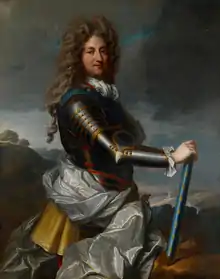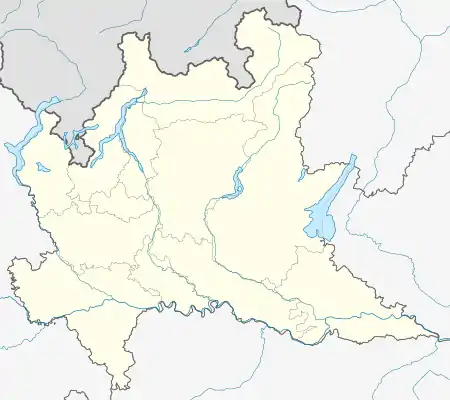Battle of Castiglione (1706)
The Battle of Castiglione took place near Castiglione delle Stiviere in Lombardy, Italy on 8 September 1706 during the War of the Spanish Succession. A French army of 12,000 attacked a Hessian corps of 10,000 that was besieging the town, forcing them to retreat with heavy losses.

| First Battle of Castiglione | |||||||
|---|---|---|---|---|---|---|---|
| Part of the War of the Spanish Succession | |||||||
.jpg.webp) View of Castiglione delle Stiviere | |||||||
| |||||||
| Belligerents | |||||||
|
|
| ||||||
| Commanders and leaders | |||||||
| Count of Médavy | Frederick of Hesse-Kassel | ||||||
| Strength | |||||||
| 12,000 | 8,000 - 10,000 | ||||||
| Casualties and losses | |||||||
| 1,000 killed or wounded |
1,500 killed or wounded 2,500 captured | ||||||

Background
By the end of 1705, France and its allies controlled most of Northern Italy, as well as the Savoyard territories of Villefranche and the County of Savoy, now in modern-day France. The Imperial army in Italy was substantially reinforced, the Maritime Powers [lower-alpha 1] paying for another 20,000 German auxiliaries, including 10,000 Hessians and renewing an existing agreement with Prussia.[1]
The main French objective for 1706 was to capture the Savoyard capital of Turin; to prevent Imperial forces in Lombardy intervening, Vendôme attacked at Calcinato on 19 April and drove them into the Trentino valley. On 12 May, Marshall La Feuillade and an army of 48,000 men reached Turin, completing their blockade of the city on 19 June.[2] The Imperial commander Prince Eugene returned from Vienna and took the remaining troops into the Province of Verona to await the German contingents. By early July, there were 30,000 Imperial soldiers around Verona facing 40,000 French spread between the Mincio and Adige rivers.[3]
The French position looked very strong but defeat at Ramillies in May meant Vendôme and any available troops were sent to Northern France. The siege of Turin continued and although the Hessians had not yet arrived, by mid-July Prince Eugene could no longer delay marching to its relief. The new French commander in Italy, Louis XIV's nephew Philippe II, Duke of Orléans followed him, leaving the Count of Médavy and 23,000 men to guard the Alpine passes.[4]
The battle
The Hessians finally crossed the Alps in July, under the command of Frederick of Hesse-Kassel. He later became King of Sweden but was a far less talented soldier than his brother-in-law and predecessor Charles XII.
As they arrived too late to join Prince Eugene's march to Turin, the Hessians were tasked with preventing Médavy disrupting his supply routes. On 19 August, Frederick sent 2,000 men under Major-General Wetzel to Goito, a small town with a bridge across the Mincio and the French garrison evacuated the town.[lower-alpha 2] Castiglione was strongly defended and they had to wait for the heavy artillery to arrive from Arco. Frederick left 1,500 men outside the town with the rest positioned near Medole, allowing him to monitor Médavy's main force at Cremona and the crossing at Goito.[5]
The withdrawal from Goito was part of a plan by Médavy to assemble a field army without alerting Frederick by removing garrisons from key strongpoints like Cremona. He put together a force of 8,000 infantry and 4,000 cavalry, crossed the Oglio River at Marcaria and attacked around 14:00 on 8 September. Dividing his corps left Frederick outnumbered; the first assaults were repulsed but a cavalry charge led by the Irish exile Arthur Dillon caught the Hessian left wing as they were changing position and the line collapsed. Médavy then turned his attention to those outside Castiglione, many of whom surrendered; French casualties were estimated as 1,000 killed or wounded, the Hessians losing around 1,500 killed or wounded plus 2,500 captured.[6]
The remainder fell back on Valeggio; in a letter of 11 September to Marlborough, Frederick claimed his forces were reduced by sickness but although they initially drove the French back, lack of artillery forced him to retreat.[lower-alpha 3][7]
Aftermath
Médavy's victory left the strategic position unaltered; the Battle of Turin on 7 September had broken the siege and after Ramillies France could no longer spare the resources to continue fighting in Italy. Castiglione slightly improved their bargaining position but French garrisons in Lombardy were isolated and could not be reinforced, their surrender being only a matter of time.[8]
To the fury of the English and Dutch, in March 1707 Emperor Joseph signed the Convention of Milan withdrawing all French troops from Northern Italy in return for free passage back to France. In return, Joseph regained the Duchy of Milan, considered vital to the security of Austria's southern borders and spared the expense of reducing the French garrisons one by one.
He agreed to support the Anglo-Dutch proposal to capture the French base at Toulon; this would confirm Allied naval supremacy in the Western Mediterranean, support the Camisard revolt and enable Victor Amadeus to regain his Trans-Alpine possessions of Villefranche and the County of Savoy. However, at the last minute Joseph ordered Count Wirich Philipp von Daun to take 8,000 troops allocated for this campaign and capture the Spanish possession of Naples. This was complete by the end of September and the fighting in Italy ceased.[lower-alpha 4][9]
Footnotes
- Britain and the Dutch Republic
- Rivers were natural defensive barriers, as well as the best way of transporting supplies; the Mincio could only be crossed by bridge, making places like Goito doubly important.
- Marlborough's response of 29 September is a masterpiece of flattery.
- Their lack of a meant the Austrians were unable to take Sicily, while the Spanish recaptured both Naples and Sicily in 1734.
References
- Wilson, Peter (1998). German Armies: War and German Society, 1648-1806. Routledge. p. 121. ISBN 1857281063.
- Symcox, Geoffrey (1983). Victor Amadeus II: Absolutism in the Savoyard State, 1675-1730. University of California Press. p. 150. ISBN 0520049748.
- Lynn, John (1999). The Wars of Louis XIV 1667-1714. Longman. p. 309. ISBN 0582056292.
- Wilson, Peter (1998). German Armies: War and German Society, 1648-1806. Routledge. p. 121. ISBN 1857281063.
- Bancks, John (1745). The history of Francis-Eugene Prince of Savoy (2010 ed.). Gale ECCO. p. 215. ISBN 1170621236.
- Quincy, Charles Sevin (1726). Histoire Militaire Du Règne De Louis-le-grand, Roi De France (2010 ed.). Nabu Press. pp. 181–183. ISBN 1173835547.
- Marlborough, John Churchill (1845). The Letters and Dispatches of John Churchill, First Duke of Marlborough, From 1702-1712; Volume 3 (2018 ed.). Sagwan Press. pp. 154–155. ISBN 1376535238.
- Ingrao, Charles W (2010). The Habsburg Monarchy, 1618-1815. Cambridge University Press. p. 114. ISBN 978-0521785051.
- Ingrao, Charles W (2010). The Habsburg Monarchy, 1618-1815. Cambridge University Press. p. 114. ISBN 978-0521785051.
Sources
- Bancks, John; The history of Francis-Eugene Prince of Savoy; (1745);
- Falkner, James; The War of the Spanish Succession 1701-1714; (Pen and Sword, 2015);
- Lynn, John; The Wars of Louis XIV, 1667-1714; (Longman, 1999);
- O'Conor, Matthew; A Military History of the Irish Nation: Comprising a Memoir of the Irish Brigade in the Service of France;
- Wilson, Peter; German Armies: War and German Society, 1648-1806; (Routledge, 1998);